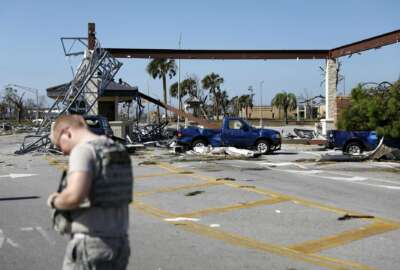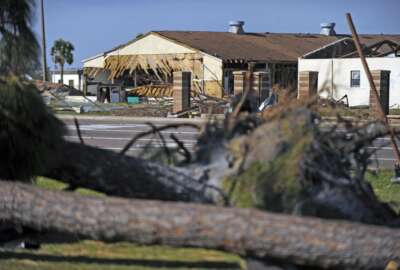
Air Force letting people assess damage to houses, F-22s minimally harmed in storm
The 11,000 people assigned to Tyndall Air Force Base will temporarily be able to collect their belongings and see their homes.
The Air Force is temporarily opening up Tyndall Air Force Base to military members, their families and civilians to evaluate their personal property after the base was devastated by Hurricane Michael a week ago.
The Air Force is opening the base from Wednesday to Sunday so residents can collect items and assess damages as part of the base clean up. Air Force leaders say it’s possible it may take years before the base returns to its full capacity.
Insurance companies will also be on base to meet with families. There are about 860 housing units on Tyndall.
Drone footage of the base shows houses with roofs ripped clean off, shingles and debris splayed across roads and lawns, and signs downed and damaged.
During a Tuesday meeting with reporters Air Force Director of Public Affairs Brig. Gen. Edward Thomas said the 11,000 people who lived and worked on the base are currently staying with friends or are on nearby Eglin Air Force Base or Hurlbert Air Field. Both of those bases are also located on the Florida panhandle, but were not as extensively damaged by the storm.
The Air Force is working through what it will do with service members, civilians and their families as the base is built back up, according to Maj. Gen. Andrew Toth, Air Force Personnel Center commander.
“None of that has been completely determined yet as we work through this process,” Toth said.
The Personnel Center is deploying teams for an initial 30 days to talk to those service members to determine to financial potential of relocations and reassignments if necessary.
“The needs from Tyndall are obviously pretty high,” Toth said.
As far as airmen who were supposed to deploy, but were disrupted by the hurricane, the Air Force is assessing them on a case-by-case basis.
Toth said Air Combat Command has the lead as to what happens with deployed and soon-to-be deployed airmen.
“We are looking across the board at ones that are going to deploy and ones that are potentially coming back,” Toth said. The Personnel Center will work with airmen to see if they are “still good to go on their deployment or would you rather have that turned off? Same thing with the airmen who are coming back, do you need to come back to Tyndall Air Force Base to take care of your family? If that’s the case we are going to do everything in our power to bring you back.”
Air Force Director of Civil Engineers John Allen said the Air Force has not seen destruction like this since Keesler Air Force Base took a hit from Hurricane Katrina in 2005. Allen said it took five years until the base was completely back to normal and six months to a year before operations could continue on the base.
Currently on Tyndall about 400 airmen are performing clean up duties, restoring power and securing the perimeter.
The F-22 issue
Tyndall is a training ground for F-22 Raptors. When the storm hit many of the jets had already moved off the base, but planes that were there for repair had to be hunkered down in hangars and left to fate.
Thomas said on first look the F-22s left behind have no major issues, however, the Air Force is not relaxing until Air Force engineers and representatives from Lockheed Martin look over the aircraft with a fine-toothed comb.
“We do not have any destroyed aircraft at Tyndall,” Thomas said. “Visually, all of the aircraft are intact. They generally look to be in good shape. Certainly some damage has been sustained by some of those aircraft, but we expect they will all be fixable, all be repairable and they will all fly again.”
The Air Force declined to release how many aircraft are on the base.
The major issue is the damage to the hangars, which Thomas said were “catastrophically” damaged.
“Roofs torn off, bricks, siding torn off the side of the hangars, debris everywhere,” Thomas said. “Some of the falling debris caused dings or minor damage and in some cases more significant damage to some of the jets. But a stark juxtaposition to the damage to the hangars and the relatively solid jets that remained inside.”
The damaged hangars make it harder for engineers to look at the planes because it may not be safe for them to enter.
There are two hangars that may be structurally sound and the Air Force is considering using those. As for the rest of the planes, the service is moving in tents that can hold two planes at a time so engineers can work on the aircraft.
Copyright © 2025 Federal News Network. All rights reserved. This website is not intended for users located within the European Economic Area.
Scott Maucione is a defense reporter for Federal News Network and reports on human capital, workforce and the Defense Department at-large.
Follow @smaucioneWFED




